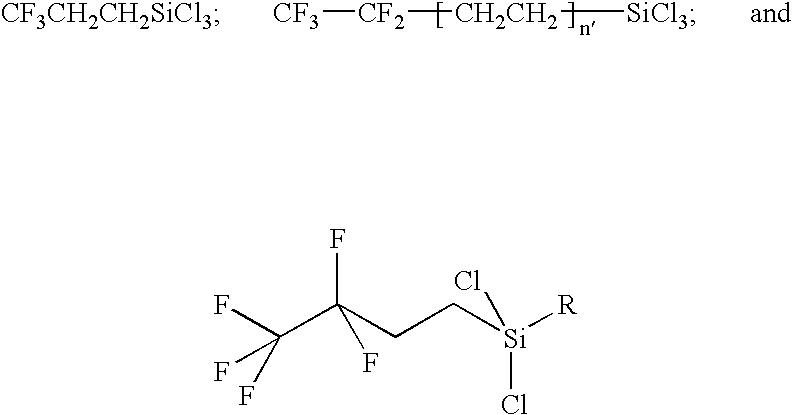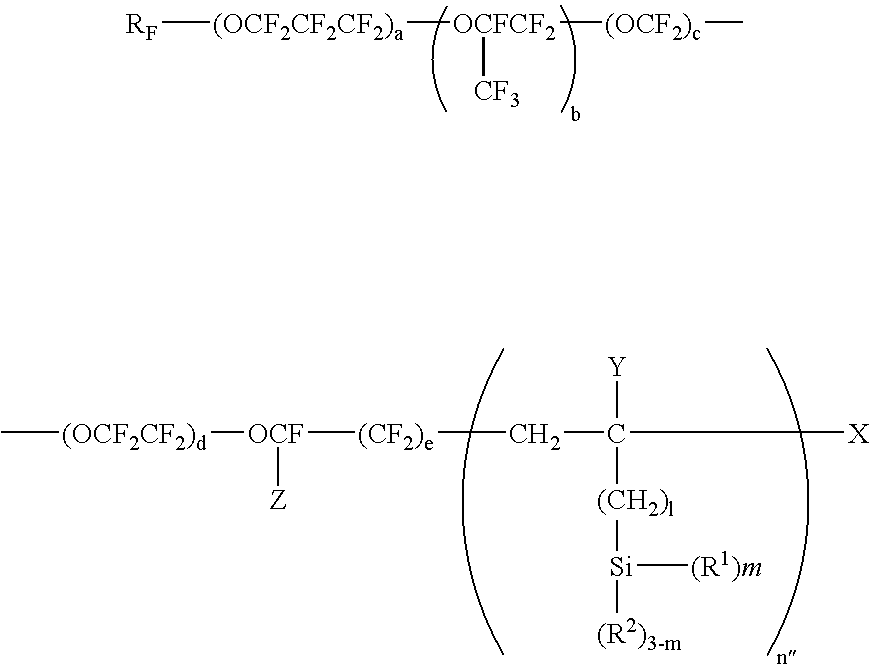Optical article having a temperature-resistant anti-reflection coating with optimized thickness ratio of low index and high index layers
a technology of anti-reflection coating and optical article, which is applied in the field of optical article, can solve the problems of affecting the thickness ratio of low index and high index layers, affecting the performance of optical articles, etc., and achieves the effect of improving the resistance to heat and temperature variations
- Summary
- Abstract
- Description
- Claims
- Application Information
AI Technical Summary
Benefits of technology
Problems solved by technology
Method used
Image
Examples
examples
1. Preparation of the Lenses: General Procedure
[0213]The optical articles used in the examples were semi-finished ORMA® 4.50 base round lenses surfaced to a power of −2.00 diopters and a diameter of 70 mm. ORMA® is a registered trade mark of Essilor. This substrate is obtained by polymerizing a diethylene glycol bis(allyl carbonate)monomer, typically CR-39®.
[0214]The lenses were spin-coated on concave side with a polysiloxane-type abrasion- and / or scratch resistant coating (hard coat; thickness: 1.8 μm) based on a hydrolyzate of GLYMO, washed in a cleaning line including washing in acetic acid, rinsing with water and deionized water followed by hot air drying) and steamed for 4 hours at 80° C. before AR-coating or 3 hours at 120° C.
[0215]The lenses were then placed on a carrousel provided with circular openings intended to accommodate the lenses to be treated, the concave side facing the evaporation sources and the ion gun.
[0216]A pumping operation was performed until a secondary va...
examples 1 to 5
For Examples 1 to 5
[0219]The dielectric materials for deposition were used under the form of granulates. SiO2 was supplied by Canon Optron Inc., ZrO2 and SiO2 / Al2O3 (LIMA®) were supplied by Umicore Materials AG, TiO2, LaTiO3, SiO2 / Al2O3 (L5®) and PrTiO3 were supplied by Merck.
[0220]The vacuum treating machine used for deposition of the anti-reflection stack was a BAK 760 vacuum chamber with Physimeca software retrofit, provided with an electron gun 8 kV for evaporation of the oxides, an ion gun of the “end-Hall” Mark II Commonwealth type for the preliminary surface preparation with argon ions, a Joule effect crucible, a quartz scale and a Meissner trap and baffle coil connected LN2 line. Thickness of the deposited layers was followed using the quartz scale, allowing stopping the evaporation once the required thickness was reached. Pressure into the chamber was measured with a Granville-Phillips Micro Ion gauge.
[0221]The layers of the AR stack were deposited without heating of the su...
examples 1 to 8
[0225]A pumping operation was performed until a secondary vacuum was reached (2.10−5 to 3.10−5 mBar). Then, the substrate surface was activated by IPC (Ion pre-cleaning) for 2 minutes (1 A, 100V). The first HI layer (TiO2, ZrO2, LaTiO3 or PrTiO3) was deposited without IAD (reactive deposition with O2; Partial O2 pressure: 8.10−5 mBar for ZrO2, 10−4 mBar for TiO2), the first LI layer (SiO2 or SiO2 / Al2O3) was deposited, the second HI layer (TiO2, ZrO2, LaTiO3 or PrTiO3) was deposited without IAD (reactive deposition with O2; Partial O2 pressure: 7.10−5 to 8.10−5 mBar for ZrO2, 10−4 mBar for TiO2. Finally, the second LI layer (SiO2 or SiO2 / Al2O3) was deposited.
[0226]Deposition rates were 0.26-0.34 nm / s for the first LI layer, 0.77-0.89 nm / s for the first HI layer, 0.27-0.35 nm / s for the second LI layer and 1-1.3 nm / s for the second HI layer.
[0227]Comparative examples CE1 to CE6, the stacks of which are described in table 1, have been prepared according to the same deposition process as...
PUM
| Property | Measurement | Unit |
|---|---|---|
| refractive index | aaaaa | aaaaa |
| thickness | aaaaa | aaaaa |
| physical thickness | aaaaa | aaaaa |
Abstract
Description
Claims
Application Information
 Login to View More
Login to View More - R&D
- Intellectual Property
- Life Sciences
- Materials
- Tech Scout
- Unparalleled Data Quality
- Higher Quality Content
- 60% Fewer Hallucinations
Browse by: Latest US Patents, China's latest patents, Technical Efficacy Thesaurus, Application Domain, Technology Topic, Popular Technical Reports.
© 2025 PatSnap. All rights reserved.Legal|Privacy policy|Modern Slavery Act Transparency Statement|Sitemap|About US| Contact US: help@patsnap.com



